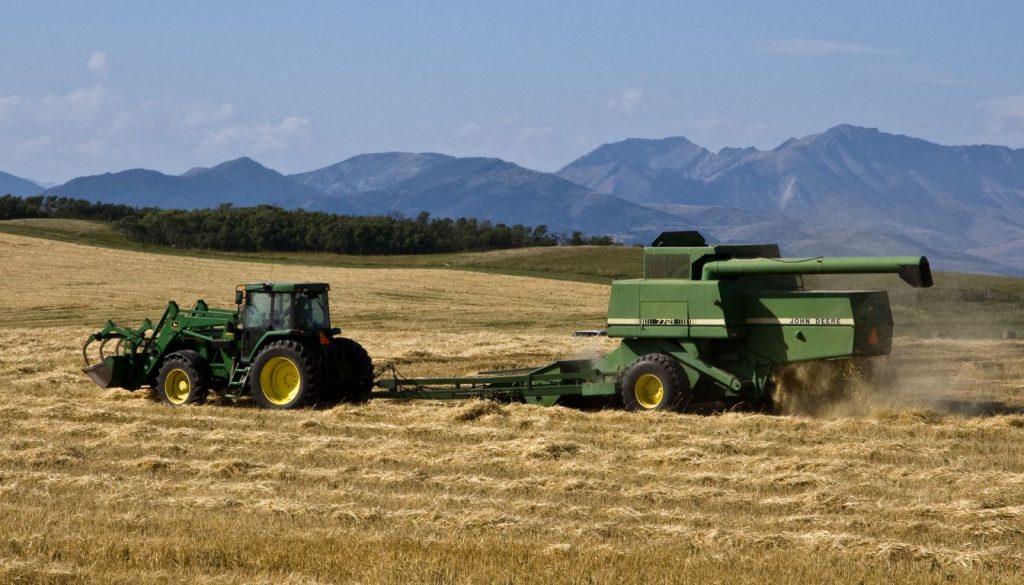Water Connections: Introduction to Water and Agriculture
What is the Connection between Water and Agriculture in Alberta?

When we think of farming, we tend to think of expansive fields of crops, farmers riding tractors, or cows eating grass next to a big red barn. Agriculture is much more than that, such as making sure crops are healthy, making sure the livestock are fed properly, irrigating crops, adapting to weather patterns, and introducing new technology to reduce costs and increase output. Water plays a major role in each of these activities, and effective water management allows our agricultural industry to thrive.
Despite its dry climate, farming in Alberta has been happening for well over a century. With its nutrient-rich soil, the province is a leading producer of canola, wheat, dry peas, barley, and cattle, and is expanding its food processing capabilities. Alberta’s arable lands and abundance of sunshine make it an ideal region to produce agricultural products of all sorts. Alberta’s extensive irrigation network allows for a wider variety of crops to be grown, as we can produce crops that need more water than is received as rain.
Why is Agriculture Important in the Province? [1]

Alberta has one of the world’s most productive agricultural sectors, [2] and it stands as Canada’s second-largest agricultural producer. In fact, 40% of Canada’s cattle are raised in Alberta and 20% of Alberta’s cleantech ventures [3] are in the agriculture tech sector.
Alberta’s abundant farmland brings enormous economic benefits. In 2022, more than 75,000 Albertans were employed by the agricultural sector, which contributed nearly $9.7 billion to the provincial economy in 2020. Moreover, the industry isn’t showing any signs of cooling off anytime soon; agricultural labour demand in Alberta is expected to grow by 1.1 per cent each year between 2022 and 2025, which is more than double the nationwide average of 0.5 per cent. Agricultural products produced in Alberta are distributed within the province and to communities worldwide – playing a massive role in food security for individuals all over the world.
What are the Connections and How Do We Illustrate Them?
We have chosen various focus areas to show the connections between water and agriculture in Alberta. Click the menu to the right to explore.
Alberta Agriculture is Growing and Innovating
Albertans take pride in their past, present and future ties to agriculture. Here are some facts on current industry players and investments in the future of agriculture [4].
- Big Marble is the largest greenhouse in Alberta.[5]. It can house over 300,000 cucumber plants, 60,000 tomato vines, and operates with 17,400 grow lights.
- GoodLeaf Farms is expected to open a 74,000 square-foot vertical farm in Calgary [6] by the end of 2022 that plans to grow fresh lettuce year-round. (Producer)
- Livestock Water Recycling is the world’s leading provider of manure treatment technology [7]. They work with farms worldwide to reduce greenhouse gas emissions, separate nutrients for fertilizer application, and recycle water. (Trade Commissioner of Canada)
- Results Driven Agriculture Research (RDAR) has made a 10-year, $370 million deal with the Government of Alberta towards research [8] regarding enhanced productivity, profitability and competitiveness, sustainable and responsible agriculture, food safety, diversification, and more.
- Today, the Alberta Government has several programs [9] to help farmers with sustainability efforts and environmental protection.
- One of those includes the Environmentally Sustainable Agriculture Tracking Survey (ESATS) [10], a farm-level survey that helps track the adoptions of such practices.
- Canadian Agriculture Partnership Water Program – The Water Program [11] assists primary producers in enhancing agricultural water management for continued growth and long-term success of the agriculture industry. There are two streams under the Water Program: 1) on-farm irrigation projects, and 2) on-farm water supply projects
- Agriculture Water Futures Program, the global case for investing in water stewardship with a focus on the agriculture supply chain in Alberta [12].
References
[1] Canada Action, February 13, 2022. Farming in Alberta: 30 Facts
[2] Growing the future of food, 2022. https://investalberta.ca/agriculture/
[3] Agtech in Alberta. Foresight Canada, 2022. https://foresightcac.com/agtech-in-alberta/
[4] Facts About Alberta. Government of Alberta-Water for Life, December 2010. https://open.alberta.ca/dataset/1832cd36-bbeb-4997-ae81-67d3eedfcfe5/resource/18a9d64b-bad8-413a-8c63-77a548ec9d88/download/4888138-2010-facts-about-water-in-alberta-2010-12.pdf
[5] Big Marble Farms, 2022. https://bigmarble.ca/always-growing
[6] Vertical farming grows in Calgary. The Western Producer, December 10, 2021. https://www.producer.com/markets/vertical-farming-grows-in-calgary/
[7] Enabling agricultural emissions reduction and sustainable supply chains. Government of Canada, 2022-01-05. https://www.tradecommissioner.gc.ca/tcs-sdc/assets/pdfs/sectors-secteurs/climate_finance-financement_international/agricultural-emissions-reduction_en.pdf
[8] A new era for agriculture research in Alberta. Government of Alberta, 2022. https://www.alberta.ca/a-new-era-for-agriculture-research-in-alberta.aspx
[9] Agriculture environmental stewardship. Government of Alberta, 2022. https://www.alberta.ca/agriculture-environmental-stewardship.aspx
[10] Environmentally Sustainable Agriculture Tracking Survey. Government of Alberta. https://www.alberta.ca/environmentally-sustainable-agriculture-tracking-survey.aspx#:~:text=The%20Alberta%20government%20sponsors%20a%20farm-level%20survey%20to,provide%20valuable%20information%20about%20ESA%20progress%20in%20Alberta.
[11] Canadian Agricultural Partnership Water Program. Government of Alberta, 2022.
https://www.alberta.ca/canadian-agricultural-partnership-water-program.aspx
[12] Agriculture Water Futures Program – The case for investing in stewardship. Mike Nemeth, May 24, 2018. Alberta Innovates Water Innovation. Program Forum. Alberta WaterSMART.
Thank you to our generous sponsors for the Water Connections Project
This phase of the project has been made possible by Nutrien, Enbridge, and Manulife Financial, along with the Government of Canada and the Government of Alberta through the Canadian Agricultural Partnership.

